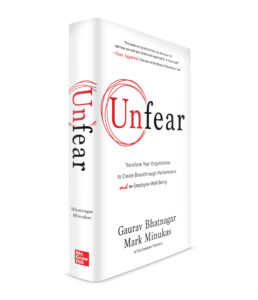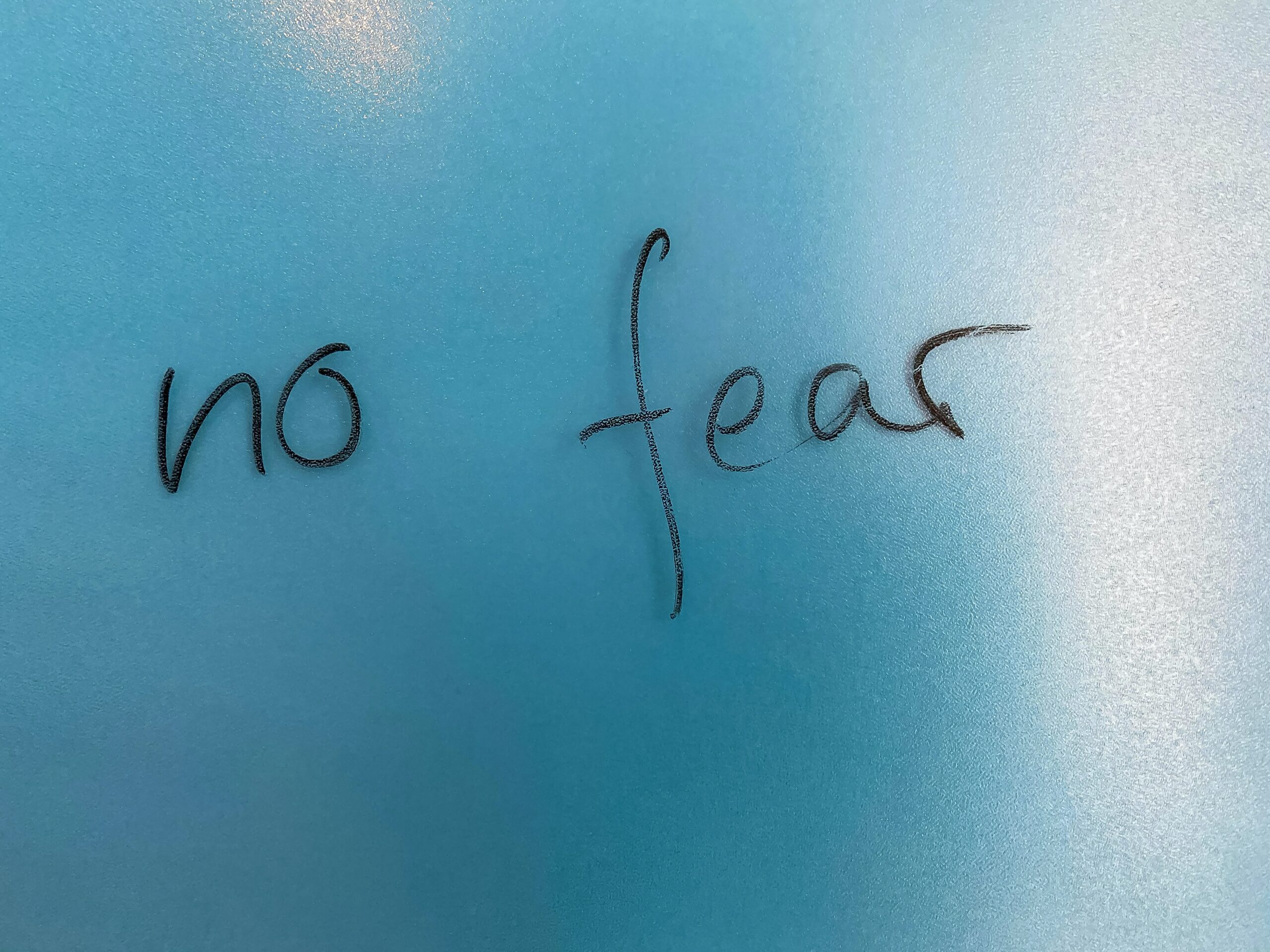Beyond Fear
Fear can grip individuals and organizations. I have seen companies with fear-based cultures and its dangerous impact. Two experts on business transformations, Gaurav Bhatnagar and Mark Minukas, have written Unfear: Transform your Organization to Create Breakthrough Performance and Wellbeing. It shows you how to reframe your relationship with fear and anxiety to unlock extraordinary performance and personal wellbeing for you, your team, and your organization.
No organization is ever completely free of fear. Instead, knowing how to reframe fear, to use its power, and to become resilient is key to success.
I recently spoke to the authors about their research on fear.
Why does fear so easily overtake an organization?
Gaurav: For a few reasons. First of all, organizations are made up of human beings and as human beings we are all prone to fear. And yet fear is a taboo topic within organizations and therefore it is not discussed. It just seeps in insidiously with everyone pretending it doesn’t exist. Secondly, organizations have historically been deeply hierarchical, and deeply hierarchical structures create deeply unequal power. And this makes for a fertile ground for fear to germinate. Finally, organizations today are living in a highly volatile environment with pressure for ever-increasing short-term profits and that is yet another factor that creates the perfect recipe for fear to permeate and get deeply embedded in organizations.
Mark: Another big reason fear overtakes organizations is because fear works in the short run. Fear motivates people to take action (or not take action depending on your own life experiences). We react to fear in ways that keep us safe in our minds. The challenge is we become blind to all of the ways that our reactions to fear no longer serve us and keep us stuck in ineffectiveness.
What are the signs? What have you noticed in corporate cultures rife with fear throughout?
Gaurav: There are two patterns of behavior that show up in corporate cultures rife with fear that are mutually reinforcing. One pattern is called the Fight Club – which is an Aggressive/Defensive pattern where the organization responds to fear with aggression. This shows up as people micro-managing or controlling others, obsessively finding mistakes, getting competitive across siloes or even with colleagues within one’s team and becoming overly perfectionistic with how one engages with tasks.
Mark : The other pattern is what we call the Nice Club which is a Passive/ Defensive pattern. This shows up as people avoiding difficult decisions or difficult conversations, blindly doing what people higher in the hierarchy tell them to do, robotically following rules or, finally, just doing things to be liked by others. None of these patterns are the result of bad intentions, they are merely dysfunctional reactions in the face of fear.
What is Unfear?
Mark: It’s a word we made up😊 And we did that to emphasize that what we are talking about is not fearlessness or eliminating fear. Fear will exist for all of us, especially in times of change and uncertainty. Unfear is learning to notice how fear arises for you and to use that fear to make more creative and effective choices in your life rather than falling back into ineffective habitual patterns.
To do this, you can’t see fear as a good or bad thing. It’s just a signal that you have something to pay attention to, a learning edge.
Gaurav: Unfear is fundamentally about reframing your narrative about fear to see it as an opportunity to learn and grow. It is grounded in the firm belief that more important than the fear itself is the story we have about the fear. We can have a narrative that collapses us into a fight or flight response, or we can have a narrative that allows us to consciously choose a creative response, a third way so to speak. And the way we do this is through our capacity of imagination and language, which really are two superpowers that human beings have to reframe our narrative about any situation. And the reframe actually lets us see possibilities that we didn’t when we were in a reactive habitual fight flight pattern.
Should a leader ever use fear?
Gaurav: A leader should never use fear other than in exceptional circumstances. These exceptional circumstances are when the survival of the organization is at stake and extremely sharp short-term actions are required to ensure that the organization survives the immediate circumstance. However, the leader must understand that there are significant long-term consequences of these actions, namely, breakdown of trust in management, loss of morale, employees feeling that the social contract between them and the organization is broken and that the organization doesn’t walk its talk on values.
And the leader needs to be willing to embrace those consequences and plan to address those consequences rather than give excuses for them or pretending not to notice them. When the organization is back on its feet, it will need to do some serious work on culture because pain is like Velcro and the negative stories that people have about the organization will stick around unless dealt with head on.
Mark: Very much agree. I’ll just add that setting high aspirations for an organization can still be done without fear. Notice the story you want to tell about a target or aspiration. Are you asking people to stretch in this way because “bad things will happen” otherwise? Or are you asking people to stretch because “this will help us get to an amazing place”? To unfear is to let the positive future vision pull you forward.
Martin Luther King, Jr. said, “I have a dream…” and NOT “I have a nightmare that things won’t change…”
The archetypes were fascinating and may be too difficult to go into detail here, but I’d love for you to share the concept and how these can be used by leaders.
Mark: Our hope is that the archetypes make it easier for leaders to spot opportunities to improve – either for themselves or for their organization. Fear is such a taboo topic, no one readily wants to admit that they experience fear. It’s easier and more tangible to identify a pattern of behavior. Once you can see that pattern and understand how it’s creating dysfunction, then people can begin the work of unpacking why that behavior exists and how to shift out of it.
Gaurav: For instance, let’s say a leader sees a Fault Finder pattern in their organization. With a shared language, the leader can engage individuals or teams with that archetype in a very tailored unfear conversation. The leader can help people understand the story or belief that is driving the behavior. Perhaps there’s a story that finding mistakes is how people get rewarded in the organization. This is a big insight! Now the leader can work with people to shift this story and the reasons it exists. This could lead to better communication in the organization, a redesigned performance management system, more celebration of success, better coaching skills, you name it.
Rather than generic solutions, a leader can home in on specific solutions based on the specific archetypes in the organization.
If you are someone who feels like a victim, and you know you fall into fear (founded or not), what strategies are best for returning to an empowered state?
Gaurav: The core underpinning of a victim mindset is self-disempowerment relative to the situation or a person you are facing. In order for you to break this reactive stance the first step is to understand that you like any individual have infinite potential to deal with your challenges. The second step in accessing your infinite potential is by pressing the metaphorical pause button when you find yourself slipping into a habitual fear reaction. The pause allows you to see that you are slipping into a victim response and create the space to self-regulate and modulate yourself. Third once you have created the space you step into a more considered response by asking one of three questions: What different choice can I make? What can I learn from this situation? And the third, which is a more difficult and philosophical question, why have I created this situation in my life?
Ultimately this is a short-term fix which does not fundamentally alter our relationship to fear. The more transformational approach is the practice of meditation and mindfulness which over time removes the fear imprints in our psyche that the amygdala part of brain refers to when reacting to stimuli as a victim.
Touch briefly on creating an Unfear culture. How do you best allow it to take root and grow?
Mark: Organizations don’t transform, people do. This is because the fundamental building block of any organizational system is the human being. What this implies is that to unfear a whole system you have to unfear a critical mass of individuals and teams. You have to create a movement! Not a contagion of fear…but a contagion of unfear. Individuals need to choose to show up differently and then start to inspire more and more of their colleagues to do the same. This process may start slow, but it leads to much higher levels of sustained performance longer-term.
Gaurav : The journey to an unfear culture requires an inside-out transformation. This means first addressing the individual and collective mindsets and then working on the artifacts that these mindsets create. For example, say there’s a Likable or Avoider culture where the individual artifact is that people hesitate to speak up. At a team level the artifact might be low levels of trust. And at the organization level the artifact might be a short-term strategy that prioritizes cost-cutting at the expense of long-term growth. To unfear this culture, we’d first help individuals understand and change their hesitation to speak up. We’d help teams actively improve their skills in building trust, having difficult conversations, and encouraging others to speak up. Then we’d help formal leaders and a powerful cadre of informal role models shift the overall narrative or story about where the organization is headed and why.
Interventions on the individual, team, and organizational levels in a situation like this would lead to a new culture where people speak up, information is exchanged more freely, where people are energized about the direction of the organization, and where creative problem solving happens much more naturally.
For more information, see Unfear: Transform your Organization to Create Breakthrough Performance and Wellbeing.
Image Credit: Etienne Girardet

